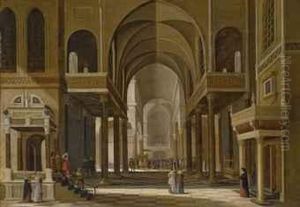Anton Gunther Ghering Paintings
Anton Günther Ghering, sometimes spelled as Gerings or Gehring, was a Baroque etcher and engraver of uncertain origin. He is believed to have been born around 1630, but specific details about his early life, including the exact place and date of his birth, remain obscure. Similarly, little is known about his death, which is estimated to have occurred around 1695.
Ghering's work is characterized by its intricate detail and often involved religious and allegorical subjects, which were common themes in the Baroque period. He was heavily influenced by the dramatic style of the time, which sought to evoke emotion and grandeur. His engravings often included rich textures and deep contrasts between light and shadow, a technique known as chiaroscuro, which was used to great effect by many artists of the Baroque era to create a sense of three-dimensionality on a flat surface.
Despite the lack of comprehensive biographical details, Ghering’s artistic contribution can be assessed through his surviving works. He is known to have been active in various parts of Europe, with possible connections to Italy and the Netherlands, which were significant centers for the arts during the 17th century. Ghering’s engravings were sometimes based on the works of other artists, which was a common practice at the time; engravers played a crucial role in the dissemination of artistic styles and ideas across Europe by reproducing and distributing images.
Unfortunately, because Ghering was not as prominent as some of his contemporaries, his work has not been studied as extensively, and as a result, the catalogue of his artistry is not as well documented. However, the quality of his etchings suggests that he was a skilled engraver with a fine understanding of the Baroque aesthetic. In the absence of more specific biographical information, Anton Günther Ghering remains a somewhat enigmatic figure in art history, known primarily through the artistic legacy he left behind.
